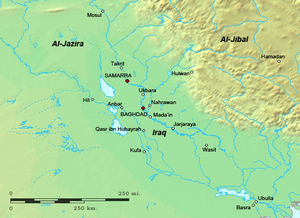|
Hasan ibn Ustadh-HurmuzAbu Ali Hasan ibn Ustadh-Hurmuz (Arabic: أبو علي حسن بن أستاذ هرمز), commonly known after his father as Ibn Ustadh-Hurmuz (ابن أستاذ هرمز) (died 1011) was a Daylamite[1] military officer of the Buyids, and an important figure in the Buyid state during the late 10th century. Biography OriginsHe was the son of Ustadh-Hurmuz, a prominent Buyid chamberlain (hajib), who, after the death of the Buyid king Adud al-Dawla, began serving the latter's eldest son Sharaf al-Dawla, who was the ruler of Fars, and fought for complete control of the Buyid Empire against his younger brother Samsam al-Dawla, who was the ruler of Iraq. During this period, Ustadh-Hurmuz was appointed by Sharaf al-Dawla as the governor of Oman. However, wishing to change his allegiance to Sharaf al-Dawla's brother, he was forced to retire in 984. Service under the Buyids of FarsDuring this period, Ibn Ustadh-Hurmuz was about 23 years old and was already in the service of Samsam al-Dawla; but in 987, Samsam al-Dawla was defeated and captured by Sharaf al-Dawla, who shortly annexed Iraq. He, however, died himself one year later, and was succeeded by his younger brother Baha' al-Dawla in Iraq, while Samsam al-Dawla managed to escape from captivity and fled to Fars, where he managed to conquer the entire region, and was joined by Ibn Ustadh-Hurmuz including other of his former officers such as Fuladh ibn Manadhar. In 995, Ibn Ustadh-Hurmuz became the leader of his Daylamite kinsmen in the Buyid army,[1] thus giving him a powerful position in the Buyid Empire. Two years later, he captured Ahvaz, but in the following year, Samsam al-Dawla was killed during a revolt by the sons of the deceased former Buyid ruler Izz al-Dawla.  Service under the Buyids of IraqIbn Ustadh-Hurmuz quickly used the opportunity to transfer his allegiance to Baha' al-Dawla,[2][3] who became the new ruler of Fars. In 999/1000, Ibn Ustadh-Hurmuz succeeded his brother al-Hajjaj as governor of Khuzistan, when the latter was sent to become governor of Iraq.[3] In August 1000, he was appointed to the vizierate at Shiraz in place of al-Muwaffaq, before being sent to Baghdad as vizier and governor of Iraq in October 1002.[3] There he managed to defeat his brother, who had risen in revolt and was supported by Kurds and Shayban Arabs.[4] He also defended Iraq against incursions from Batihah and the Hasanwayhid ruler Badr ibn Hasanwayh. Furthermore, Ibn Ustadh-Hurmuz managed to suppress the rebellion of the Uqaylid ruler Qirwash, who had briefly taken control of a few Buyid cities and had changed his allegiance to the Fatimid Caliphate.[5] Ibn Ustadh-Hurmuz later died on 14 December 1010 at Baghdad,[3] and was succeeded by Fakhr al-Mulk, who had previously replaced Ibn Ustadh-Hurmuz in Shiraz, as vizier and governor of Iraq.[1][6] Ibn Ustadh-Hurmuz's father, however, outlived his son, and lived until 1015. References
Sources
|